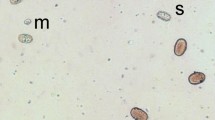Summary
Three non-tuberous Solanum species of series Etuberosa-S. brevidens (brd), S. etuberosum (etb) and S. fernandezianum (frn)-upon selfing displayed compatible berry set but seed set varied and on an average was below normal. Also in crosses between species berry set was unhampered (apart from the crosses with short-styled frn as pollen plant), but the interspecific hybrid plants showed various degrees of sterility and a low average seed set upon selfing. Cytological investigations revealed that in pure species-plants semi-sterility regularly occurred and was invariably associated with multivalent associations (up to decavalents). This may account for the decreased seed set found after selfing and intercrossing. Meiosis in F1-hybrids was even more irregular, 75% of the pmc's showing multivalents involving from 4 to as many as 22 chromosomes in various complicated configurations in which even numbers of chromosomes were predominant. However, anaphase I separation was numerically balanced in more than 75% of the cells. Pollen stainability was very low in the hybrids.
It is concluded that heterozygous translocations occur within each species and that the genomes of the species are differentiated by means of gross structural changes. In view of this and of the high chromosome pairing affinity the genome symbols E 1, E 2 and E 3 are proposed for etb, brd and frn, respectively.
Crossability of the Etuberosa species with tuberous S. pinnatisectum (pnt) was slightly more successful (average 2.7 seeds/berry) than that of Etuberosa species hybrids with S. pinnatisectum (average 1.7 seed/berry). In the hybrids studied-etb × pnt, frn × pnt and (brd × etb) × pnt-a high frequency of univalents was the rule (range 6–16 per cell). In addition rod bivalents (4–8 per cell) and a low frequency of trivalents occurred (0–3 in the biparental hybrids and 1–4 in the trispecific hybrid).
Utilization of the valuable characters of Etuberosa for potato breeding is dependent on the degree of gene exchange between Etuberosa chromosomes and chromosomes of tuberous species. In the diploid hybrids such exchange, though limited, may take place through bivalents and trivalents. As shown in this article such diploid hybrids are non-crossable because of complete male and female sterility. Only after doubling the number of chromosomes the hybrids are fertile and can be used for further crosses.
Similar content being viewed by others
References
Hawkes, J. G., 1958. Kartoffel. I. Taxonomy, cytology and crossability. In: Rudorf & Kappert (Eds), Handbuch der Pflanzenzüchtung 3: 1–43.
Hermsen, J. G. Th., M. S. Ramanna & Z. Sawor, 1981. The effect of chromosome doubling on fertility, meiotic behaviour and crossability of Solanum etuberosum × S. pinnatisectum. Euphytica 30: 33–39.
Hermsen, J. G. Th. & L. M. Taylor, 1979. Successful hybridization of nontuberous Solanum etuberosum Lindl. and tuber-bearing S. pinnatisectum Dun. Euphytica 28: 1–7.
Ramanna, M. S. & J. G. Th. Hermsen, 1979. Unique meiotic behaviour in F1 plants from a cross between a non-tuberous and a tuberous Solanum species in section Petota. Euphytica 28: 9–15.
Ross, R. W. & P. R. Rowe, 1979. Utilizing the frost resistance of diploid Solanum species. Amer. Potato J. 46: 5–13.
Author information
Authors and Affiliations
Rights and permissions
About this article
Cite this article
Ramanna, M.S., Hermsen, J.G.T.H. Structural hybridity in the series Etuberosa of the genus Solanum and its bearing on crossability. Euphytica 30, 15–31 (1981). https://doi.org/10.1007/BF00033655
Received:
Issue Date:
DOI: https://doi.org/10.1007/BF00033655




